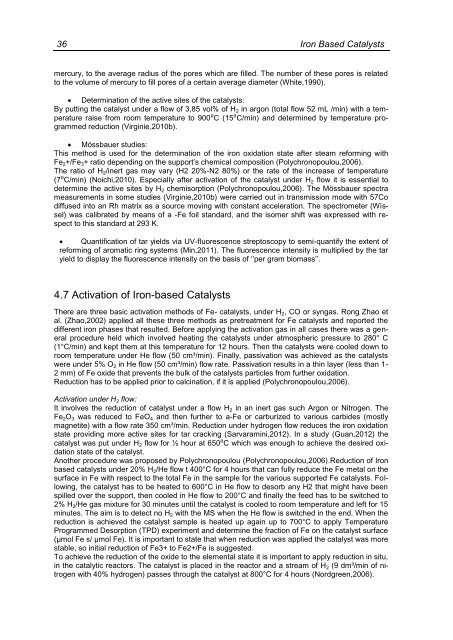Dipl. Ing. Matthias Mayerhofer Technische Universität München ...
Dipl. Ing. Matthias Mayerhofer Technische Universität München ...
Dipl. Ing. Matthias Mayerhofer Technische Universität München ...
Create successful ePaper yourself
Turn your PDF publications into a flip-book with our unique Google optimized e-Paper software.
36 Iron Based Catalysts<br />
mercury, to the average radius of the pores which are filled. The number of these pores is related<br />
to the volume of mercury to fill pores of a certain average diameter (White,1990).<br />
Determination of the active sites of the catalysts:<br />
By putting the catalyst under a flow of 3,85 vol% of H2 in argon (total flow 52 mL /min) with a temperature<br />
raise from room temperature to 900⁰C (15⁰C/min) and determined by temperature programmed<br />
reduction (Virginie,2010b).<br />
Mössbauer studies:<br />
This method is used for the determination of the iron oxidation state after steam reforming with<br />
Fe2+/Fe3+ ratio depending on the support’s chemical composition (Polychronopoulou,2006).<br />
The ratio of H2/inert gas may vary (H2 20%-N2 80%) or the rate of the increase of temperature<br />
(7⁰C/min) (Noichi,2010). Especially after activation of the catalyst under H2 flow it is essential to<br />
determine the active sites by H2 chemisorption (Polychronopoulou,2006). The Mössbauer spectra<br />
measurements in some studies (Virginie,2010b) were carried out in transmission mode with 57Co<br />
diffused into an Rh matrix as a source moving with constant acceleration. The spectrometer (Wissel)<br />
was calibrated by means of a -Fe foil standard, and the isomer shift was expressed with respect<br />
to this standard at 293 K.<br />
Quantification of tar yields via UV-fluorescence streptoscopy to semi-quantify the extent of<br />
reforming of aromatic ring systems (Min,2011). The fluorescence intensity is multiplied by the tar<br />
yield to display the fluorescence intensity on the basis of ‘’per gram biomass’’.<br />
4.7 Activation of Iron-based Catalysts<br />
There are three basic activation methods of Fe- catalysts, under H2, CO or syngas. Rong Zhao et<br />
al. (Zhao,2002) applied all these three methods as pretreatment for Fe catalysts and reported the<br />
different iron phases that resulted. Before applying the activation gas in all cases there was a general<br />
procedure held which involved heating the catalysts under atmospheric pressure to 280° C<br />
(1°C/min) and kept them at this temperature for 12 hours. Then the catalysts were cooled down to<br />
room temperature under He flow (50 cm³/min). Finally, passivation was achieved as the catalysts<br />
were under 5% O2 in He flow (50 cm³/min) flow rate. Passivation results in a thin layer (less than 1-<br />
2 mm) of Fe oxide that prevents the bulk of the catalysts particles from further oxidation.<br />
Reduction has to be applied prior to calcination, if it is applied (Polychronopoulou,2006).<br />
Activation under H2 flow:<br />
It involves the reduction of catalyst under a flow H2 in an inert gas such Argon or Nitrogen. The<br />
Fe2O3 was reduced to FeO4 and then further to a-Fe or carburized to various carbides (mostly<br />
magnetite) with a flow rate 350 cm³/min. Reduction under hydrogen flow reduces the iron oxidation<br />
state providing more active sites for tar cracking (Sarvaramini,2012). In a study (Guan,2012) the<br />
catalyst was put under H2 flow for ½ hour at 650⁰C which was enough to achieve the desired oxidation<br />
state of the catalyst.<br />
Another procedure was proposed by Polychronopoulou (Polychronopoulou,2006).Reduction of Iron<br />
based catalysts under 20% H2/He flow t 400°C for 4 hours that can fully reduce the Fe metal on the<br />
surface in Fe with respect to the total Fe in the sample for the various supported Fe catalysts. Following,<br />
the catalyst has to be heated to 600°C in He flow to desorb any H2 that might have been<br />
spilled over the support, then cooled in He flow to 200°C and finally the feed has to be switched to<br />
2% H2/He gas mixture for 30 minutes until the catalyst is cooled to room temperature and left for 15<br />
minutes. The aim is to detect no H2 with the MS when the He flow is switched in the end. When the<br />
reduction is achieved the catalyst sample is heated up again up to 700°C to apply Temperature<br />
Programmed Desorption (TPD) experiment and determine the fraction of Fe on the catalyst surface<br />
(μmol Fe s/ μmol Fe). It is important to state that when reduction was applied the catalyst was more<br />
stable, so initial reduction of Fe3+ to Fe2+/Fe is suggested.<br />
To achieve the reduction of the oxide to the elemental state it is important to apply reduction in situ,<br />
in the catalytic reactors. The catalyst is placed in the reactor and a stream of H2 (9 dm³/min of nitrogen<br />
with 40% hydrogen) passes through the catalyst at 800°C for 4 hours (Nordgreen,2006).
















